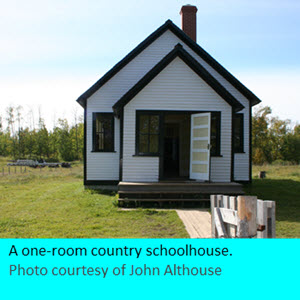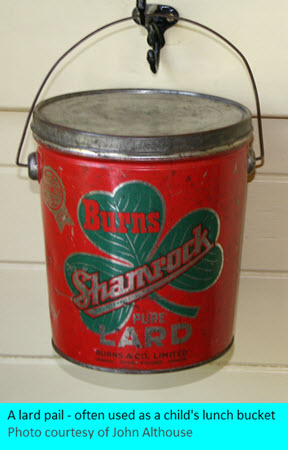Visiting Alberta’s Past :
What Was It Like When You Were My Age?
by John Althouse
This question is often asked by children and provide an excellent opportunity to introduce young people to the past. You certainly can regale the child with tales of that time, but to make more of an impression you might have him or her relive that past by providing a hands-on experience of living the life you once knew.
In an earlier issue of Relatively Speaking in an article Mavis Nelson ("The A Mavis Race," v.42 #2, May 2014), outlined how she created an activity at a family reunion where the younger members of her family experienced some of the places and activities familiar to her when she was their age. If you have the necessary materials to do this, you can provide the activities for the young people to do that once were so familiar to you. You could even provide them with the activities of one entire typical day of your childhood. You could even have them wear the style of clothes which you wore at the time.
 Many of us no longer have the materials needed to carry such an activity, however, there is an alternative way that you may allow young people to experience the past. You could visit a historic site that covers the period of your childhood and use the artifacts there to discuss the days of your or your parents’ childhood. Many of Alberta’s museums and historic sites have programs that immerse children in the past by having them engage in activities as they were then. They can experience the past in various ways at these sites. They may attend classes in the typical one-roomed school experiencing: spelling bees, thick red pencils, perhaps even slates, the singing of God Save the King and a highly regimented environment. They might get to do actual chores that a child of their age would have been expected to carry out. They might learn about the leisure activities in a time before electronic video games and television. The programs available to children at museums and historic sites vary considerably. Check to see if the ones in your area have such programs and what these programs include.
Many of us no longer have the materials needed to carry such an activity, however, there is an alternative way that you may allow young people to experience the past. You could visit a historic site that covers the period of your childhood and use the artifacts there to discuss the days of your or your parents’ childhood. Many of Alberta’s museums and historic sites have programs that immerse children in the past by having them engage in activities as they were then. They can experience the past in various ways at these sites. They may attend classes in the typical one-roomed school experiencing: spelling bees, thick red pencils, perhaps even slates, the singing of God Save the King and a highly regimented environment. They might get to do actual chores that a child of their age would have been expected to carry out. They might learn about the leisure activities in a time before electronic video games and television. The programs available to children at museums and historic sites vary considerably. Check to see if the ones in your area have such programs and what these programs include.
 When young people are able to relive the activities that were a typical part of your childhood, they will understand that chapter of family life much more fully. They may be surprised and perhaps even shocked at what you regarded as quite normal. Remember, they are viewing what you did from a completely different frame of reference from how you saw these activities as when you were their age. Make them time travellers! Such hands-on experiences will enhance the young person’s understanding of the past, provide him or her with a context for further discussion, and undoubtedly lead to many more questions on the past and their family’s place in it. It may well be the motivator that will lead to the child to develop an interest in the history of his or her family.
When young people are able to relive the activities that were a typical part of your childhood, they will understand that chapter of family life much more fully. They may be surprised and perhaps even shocked at what you regarded as quite normal. Remember, they are viewing what you did from a completely different frame of reference from how you saw these activities as when you were their age. Make them time travellers! Such hands-on experiences will enhance the young person’s understanding of the past, provide him or her with a context for further discussion, and undoubtedly lead to many more questions on the past and their family’s place in it. It may well be the motivator that will lead to the child to develop an interest in the history of his or her family.
Originally appeared in Relatively Speaking, v.43 #3 (Nov 2015)
